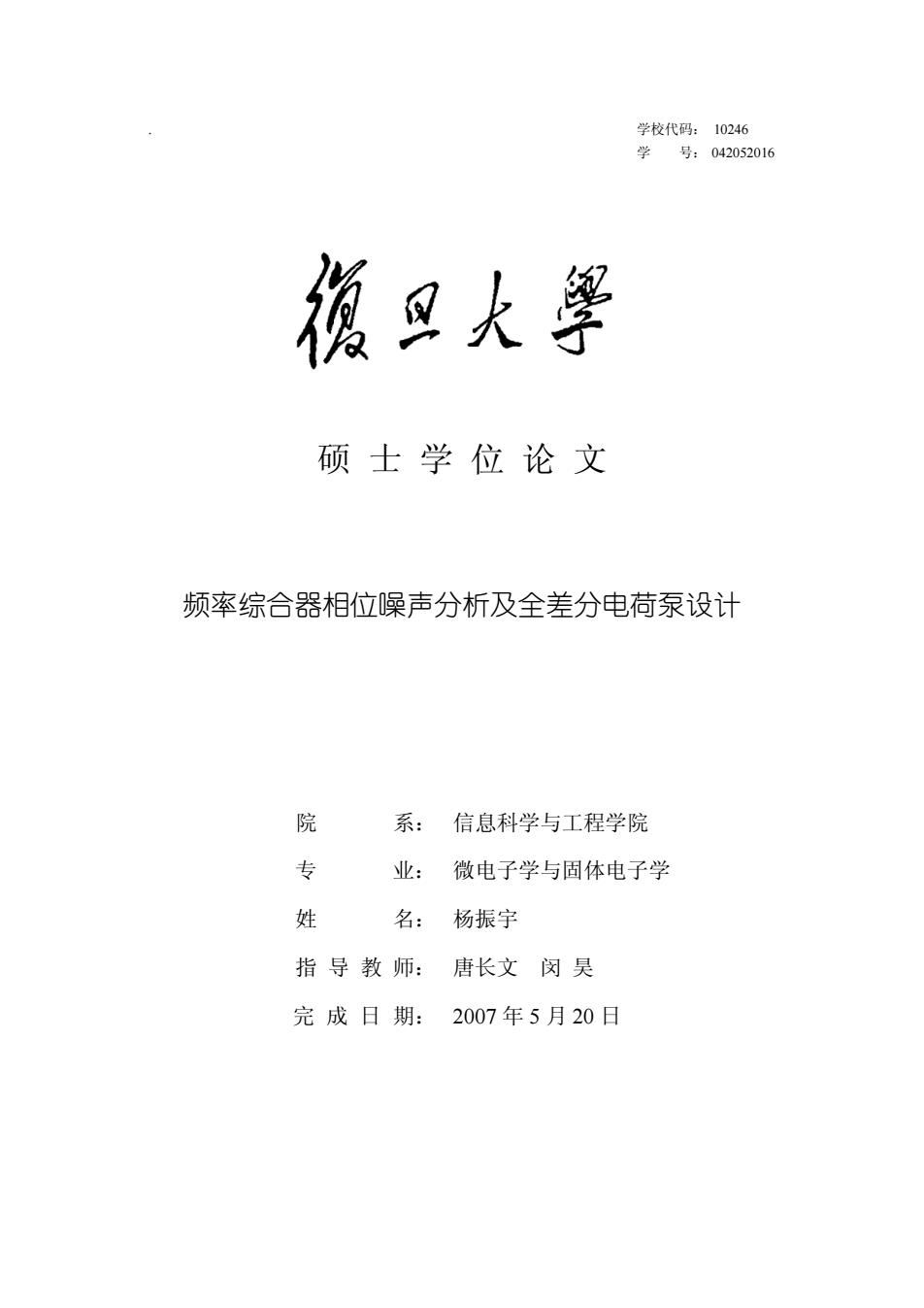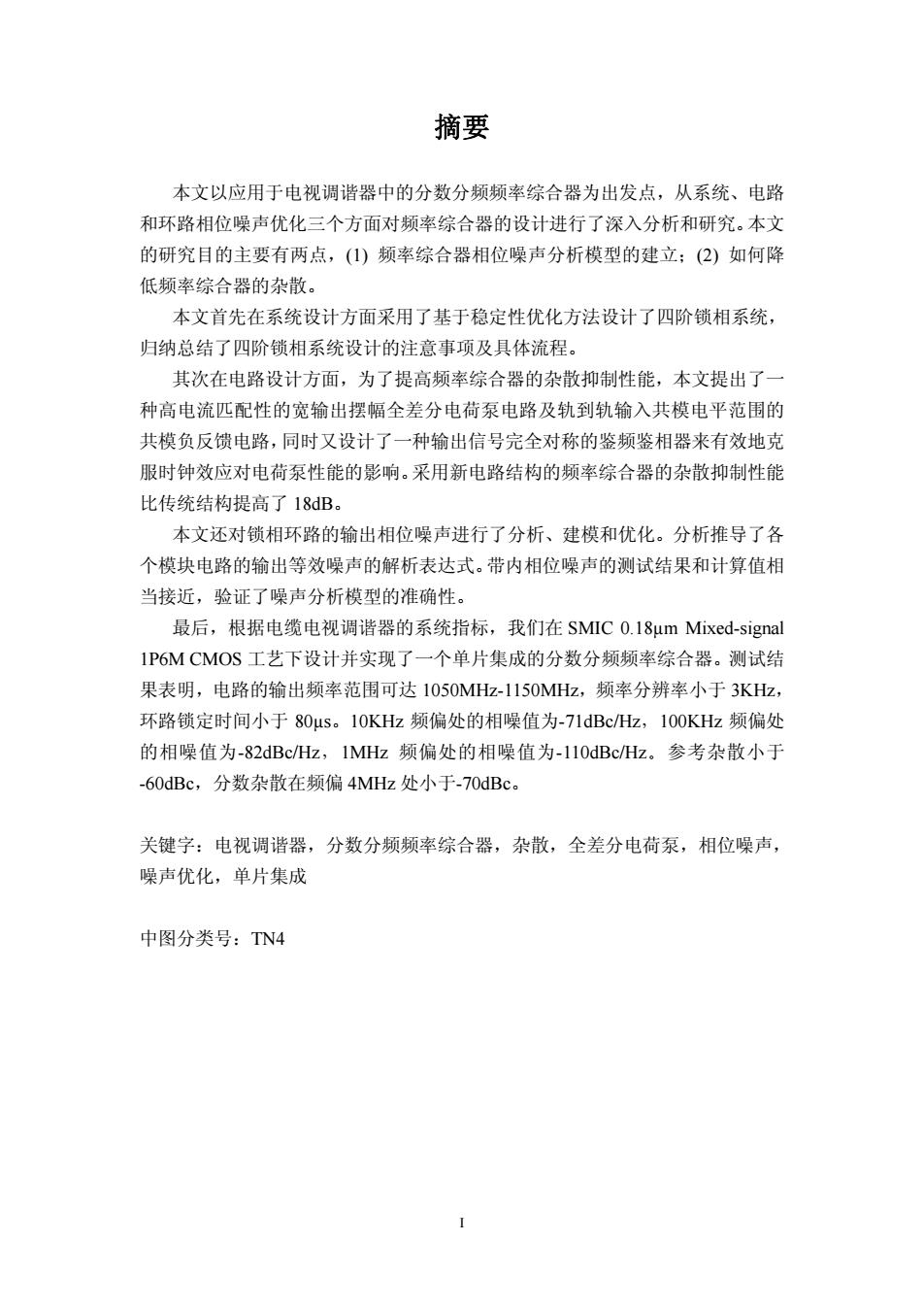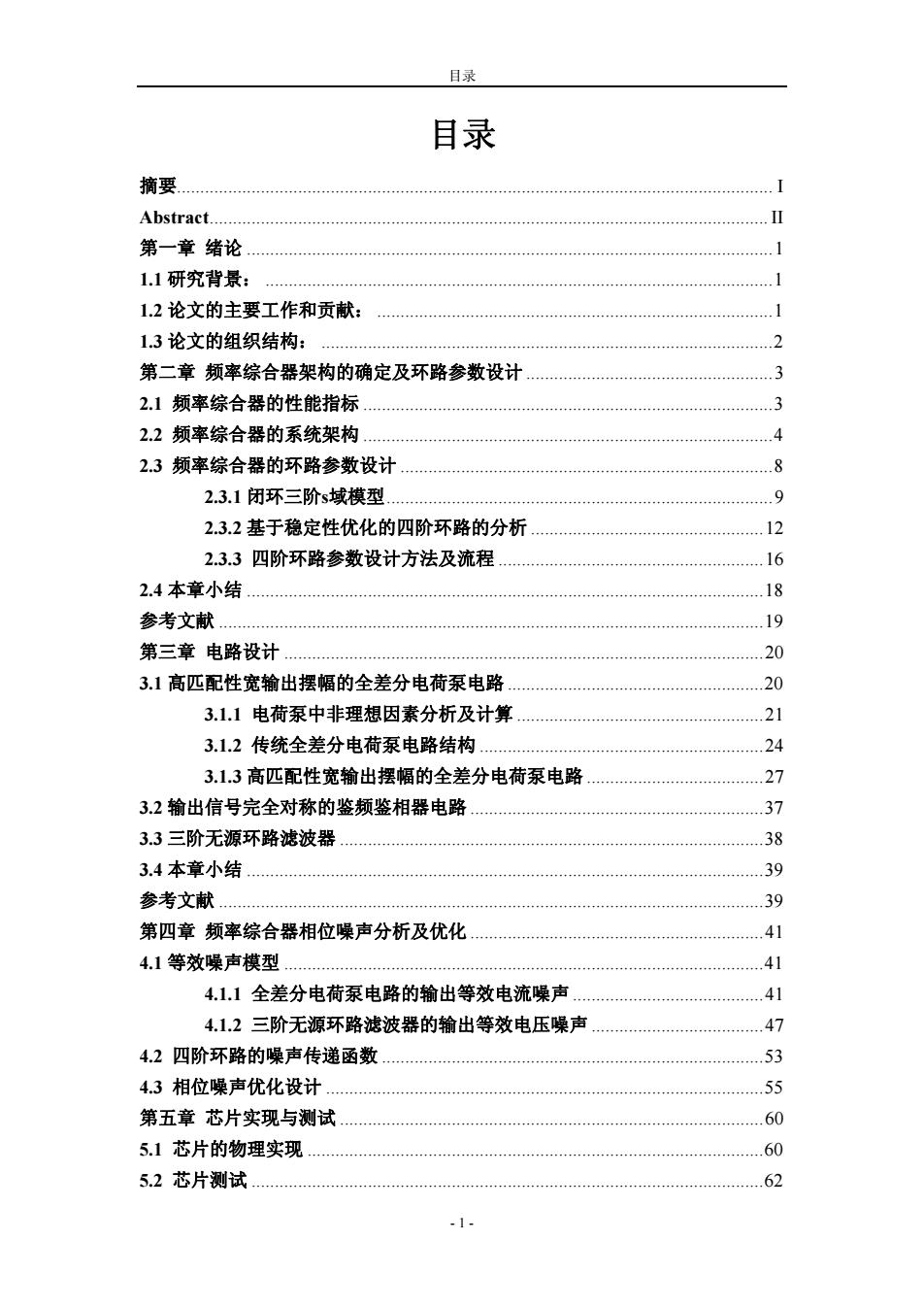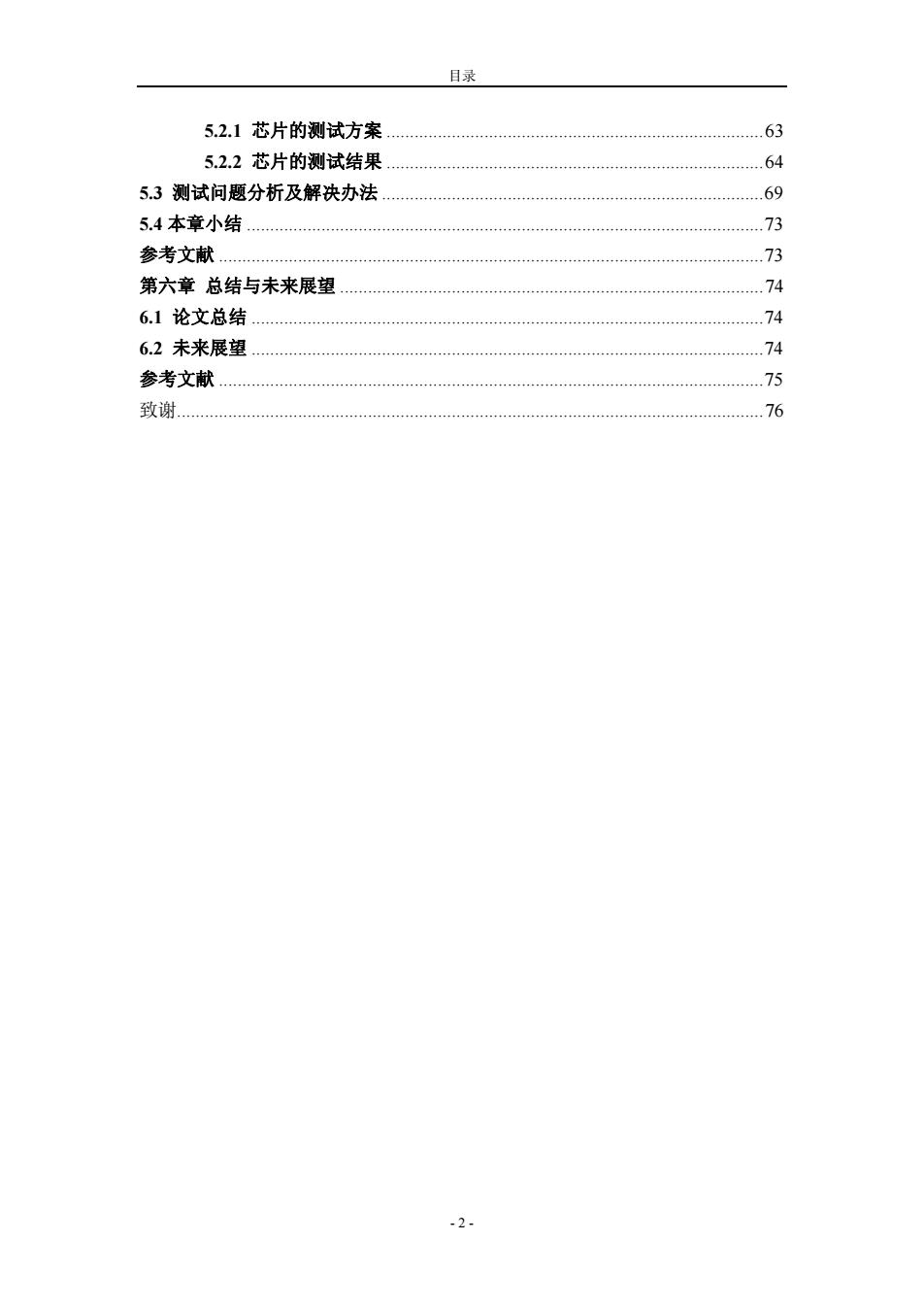
学校代码:10246 学号:042052016 復旦大季 硕士学位论文 频率综合器相位噪声分析及全差分电荷泵设计 院 系: 信息科学与工程学院 专 业: 微电子学与固体电子学 姓 名: 杨振宇 指导教师: 唐长文闵昊 完成日期: 2007年5月20日
. 学校代码: 10246 学 号: 042052016 硕 士 学 位 论 文 频率综合器相位噪声分析及全差分电荷泵设计 院 系: 信息科学与工程学院 专 业: 微电子学与固体电子学 姓 名: 杨振宇 指 导 教 师: 唐长文 闵 昊 完 成 日 期: 2007 年 5 月 20 日

摘要 本文以应用于电视调谐器中的分数分频频率综合器为出发点,从系统、电路 和环路相位噪声优化三个方面对频率综合器的设计进行了深入分析和研究。本文 的研究目的主要有两点,(1)频率综合器相位噪声分析模型的建立;(2)如何降 低频率综合器的杂散。 本文首先在系统设计方面采用了基于稳定性优化方法设计了四阶锁相系统, 归纳总结了四阶锁相系统设计的注意事项及具体流程。 其次在电路设计方面,为了提高频率综合器的杂散抑制性能,本文提出了一 种高电流匹配性的宽输出摆幅全差分电荷泵电路及轨到轨输入共模电平范围的 共模负反馈电路,同时又设计了一种输出信号完全对称的鉴频鉴相器来有效地克 服时钟效应对电荷泵性能的影响。采用新电路结构的频率综合器的杂散抑制性能 比传统结构提高了18dB。 本文还对锁相环路的输出相位噪声进行了分析、建模和优化。分析推导了各 个模块电路的输出等效噪声的解析表达式。带内相位噪声的测试结果和计算值相 当接近,验证了噪声分析模型的准确性。 最后,根据电缆电视调谐器的系统指标,我们在SMIC0.18 um Mixed-signal 1P6 M CMOS工艺下设计并实现了一个单片集成的分数分频频率综合器。测试结 果表明,电路的输出频率范围可达1050MHz-1150MHz,频率分辨率小于3KHz, 环路锁定时间小于80μs。10KHz频偏处的相噪值为-71dBc/Hz,100KHz频偏处 的相噪值为-82dBc/Hz,1MHz频偏处的相噪值为-110dBc/Hz。参考杂散小于 -60dBc,分数杂散在频偏4MHz处小于.70dBc。 关键字:电视调谐器,分数分频频率综合器,杂散,全差分电荷泵,相位噪声, 噪声优化,单片集成 中图分类号:TN4
摘要 本文以应用于电视调谐器中的分数分频频率综合器为出发点,从系统、电路 和环路相位噪声优化三个方面对频率综合器的设计进行了深入分析和研究。本文 的研究目的主要有两点,(1) 频率综合器相位噪声分析模型的建立;(2) 如何降 低频率综合器的杂散。 本文首先在系统设计方面采用了基于稳定性优化方法设计了四阶锁相系统, 归纳总结了四阶锁相系统设计的注意事项及具体流程。 其次在电路设计方面,为了提高频率综合器的杂散抑制性能,本文提出了一 种高电流匹配性的宽输出摆幅全差分电荷泵电路及轨到轨输入共模电平范围的 共模负反馈电路,同时又设计了一种输出信号完全对称的鉴频鉴相器来有效地克 服时钟效应对电荷泵性能的影响。采用新电路结构的频率综合器的杂散抑制性能 比传统结构提高了 18dB。 本文还对锁相环路的输出相位噪声进行了分析、建模和优化。分析推导了各 个模块电路的输出等效噪声的解析表达式。带内相位噪声的测试结果和计算值相 当接近,验证了噪声分析模型的准确性。 最后,根据电缆电视调谐器的系统指标,我们在 SMIC 0.18µm Mixed-signal 1P6M CMOS 工艺下设计并实现了一个单片集成的分数分频频率综合器。测试结 果表明,电路的输出频率范围可达 1050MHz-1150MHz,频率分辨率小于 3KHz, 环路锁定时间小于 80µs。10KHz 频偏处的相噪值为-71dBc/Hz,100KHz 频偏处 的相噪值为-82dBc/Hz,1MHz 频偏处的相噪值为-110dBc/Hz。参考杂散小于 -60dBc,分数杂散在频偏 4MHz 处小于-70dBc。 关键字:电视调谐器,分数分频频率综合器,杂散,全差分电荷泵,相位噪声, 噪声优化,单片集成 中图分类号:TN4 I

Abstract The purpose of the thesis is to research the fractional-N frequency synthesizer which is suitable for TV-Tuner.This thesis makes a detailed research and discussion on the design of CMOS frequency synthesizer from system,circuit and the optimization of the loop's phase noise.The research aims at two points(1)How to model the phase noise of the frequency synthesizer.(2)How to reduce the spur in the frequency synthesizer. First,in the part of PLL loop parameters design,we design a 4-order PLL based on the method of parameters design with stability optimization.And conclude the loop parameters design procedure. Then,in the part of circuits design,a novel fully differential charge pump is implemented to improve the performance of spur reduction.Based on the analysis of the drawbacks in conventional fully differential charge pumps,we proposed a fully differential charge pump circuit with perfect current matching characteristic and a rail-to-rail common-mode feedback circuit.And we also design a new PFD with symmetrical and opposite output to reduce the clock's influence.Compared with the conventional charge pumps,the ripple has decrease 18dB. Futhermore,the phase noise modeling and optimization of the fractional-N frequency synthesizer are quantitatively analyzed.The thesis has calculated the value of phase noise,which is verified by the test results. Finally,according to the cable TV Tuner specification,a fully integrated fractional-N frequency synthesizer has been implemented in SMIC 0.18um Mixed-signal 1P6M CMOS technology.The test results show that the output frequency range is from 1050MHz to 1150MHz,the minimum frequency step is 3KHz,the locking time is smaller than 80us.The values of phase noise are as followed:-71dBc/Hz@10KHz,-82dBc/Hz@100KHz,-110dBc/Hz@1MHz.The reference spur is smaller than -60dBc,and the fractional spur is smaller than -70dBc@4MHz offset. Keywords:TV-Tuner,fractional-N frequency synthesizer,spur,fully differential charge pump,phase noise,phase noise optimization,fully integrated CLC number:TN
Abstract The purpose of the thesis is to research the fractional-N frequency synthesizer which is suitable for TV-Tuner. This thesis makes a detailed research and discussion on the design of CMOS frequency synthesizer from system, circuit and the optimization of the loop’s phase noise. The research aims at two points (1) How to model the phase noise of the frequency synthesizer. (2) How to reduce the spur in the frequency synthesizer. First, in the part of PLL loop parameters design, we design a 4-order PLL based on the method of parameters design with stability optimization. And conclude the loop parameters design procedure. Then, in the part of circuits design, a novel fully differential charge pump is implemented to improve the performance of spur reduction. Based on the analysis of the drawbacks in conventional fully differential charge pumps, we proposed a fully differential charge pump circuit with perfect current matching characteristic and a rail-to-rail common-mode feedback circuit. And we also design a new PFD with symmetrical and opposite output to reduce the clock’s influence. Compared with the conventional charge pumps, the ripple has decrease 18dB. Futhermore, the phase noise modeling and optimization of the fractional-N frequency synthesizer are quantitatively analyzed. The thesis has calculated the value of phase noise , which is verified by the test results. Finally, according to the cable TV Tuner specification, a fully integrated fractional-N frequency synthesizer has been implemented in SMIC 0.18µm Mixed-signal 1P6M CMOS technology. The test results show that the output frequency range is from 1050MHz to 1150MHz, the minimum frequency step is 3KHz, the locking time is smaller than 80µs. The values of phase noise are as followed: -71dBc/Hz@10KHz, -82dBc/Hz@100KHz, -110dBc/Hz@1MHz. The reference spur is smaller than -60dBc, and the fractional spur is smaller than -70dBc@4MHz offset. Keywords: TV-Tuner, fractional-N frequency synthesizer, spur, fully differential charge pump, phase noise, phase noise optimization, fully integrated CLC number: TN II

目录 目录 摘要 Abstract.. 0 第一章绪论 1.1研究背景: 1.2论文的主要工作和贡献: 1.3论文的组织结构: 第二章频率综合器架构的确定及环路参数设计 .3 2.1频率综合器的性能指标 2.2频率综合器的系统架构 2.3频率综合器的环路参数设计 8 2.3.1闭环三阶s域模型 .9 2.3.2基于稳定性优化的四阶环路的分析 .…12 2.3.3四阶环路参数设计方法及流程 16 2.4本章小结 18 参考文献 .19 第三章电路设计 20 3.1高匹配性宽输出摆幅的全差分电荷泵电路 .20 3.1.1电荷泵中非理想因素分析及计算 .21 3.1.2传统全差分电荷泵电路结构 .24 3.1.3高匹配性宽输出摆幅的全差分电荷泵电路 .27 3.2输出信号完全对称的鉴频鉴相器电路 .37 3.3三阶无源环路滤波器 .38 3.4本章小结 39 参考文献 .39 第四章频率综合器相位噪声分析及优化 41 4.1等效噪声模型 .41 4.1.1全差分电荷泵电路的输出等效电流噪声 .41 4.1.2三阶无源环路滤波器的输出等效电压噪声 47 4.2四阶环路的噪声传递函数 .53 4.3相位噪声优化设计 .55 第五章芯片实现与测试 60 5.1芯片的物理实现 60 5.2芯片测试 .62
目录 目录 摘要................................................................................................................................ I Abstract........................................................................................................................ II 第一章 绪论 .................................................................................................................1 1.1 研究背景: .............................................................................................................1 1.2 论文的主要工作和贡献: .....................................................................................1 1.3 论文的组织结构: .................................................................................................2 第二章 频率综合器架构的确定及环路参数设计 .....................................................3 2.1 频率综合器的性能指标 ........................................................................................3 2.2 频率综合器的系统架构 ........................................................................................4 2.3 频率综合器的环路参数设计 ................................................................................8 2.3.1 闭环三阶s域模型...................................................................................9 2.3.2 基于稳定性优化的四阶环路的分析 ..................................................12 2.3.3 四阶环路参数设计方法及流程 .........................................................16 2.4 本章小结 ...............................................................................................................18 参考文献 .....................................................................................................................19 第三章 电路设计 .......................................................................................................20 3.1 高匹配性宽输出摆幅的全差分电荷泵电路 .......................................................20 3.1.1 电荷泵中非理想因素分析及计算 .....................................................21 3.1.2 传统全差分电荷泵电路结构 .............................................................24 3.1.3 高匹配性宽输出摆幅的全差分电荷泵电路 ......................................27 3.2 输出信号完全对称的鉴频鉴相器电路 ...............................................................37 3.3 三阶无源环路滤波器 ...........................................................................................38 3.4 本章小结 ...............................................................................................................39 参考文献 .....................................................................................................................39 第四章 频率综合器相位噪声分析及优化 ...............................................................41 4.1 等效噪声模型 .......................................................................................................41 4.1.1 全差分电荷泵电路的输出等效电流噪声 .........................................41 4.1.2 三阶无源环路滤波器的输出等效电压噪声 .....................................47 4.2 四阶环路的噪声传递函数 ..................................................................................53 4.3 相位噪声优化设计 ..............................................................................................55 第五章 芯片实现与测试 ...........................................................................................60 5.1 芯片的物理实现 ..................................................................................................60 5.2 芯片测试 ..............................................................................................................62 - 1 -

目录 5.2.1芯片的测试方案.… 63 5.2.2芯片的测试结果 64 5.3测试问题分析及解决办法 .69 5.4本章小结. .73 参考文献 .73 第六章总结与未来展望 74 6.1论文总结 .74 6.2未来展望 .74 参考文献 75 致谢. 76 -2
目录 5.2.1 芯片的测试方案 .................................................................................63 5.2.2 芯片的测试结果 .................................................................................64 5.3 测试问题分析及解决办法 ..................................................................................69 5.4 本章小结 ...............................................................................................................73 参考文献 .....................................................................................................................73 第六章 总结与未来展望 ...........................................................................................74 6.1 论文总结 ..............................................................................................................74 6.2 未来展望 ..............................................................................................................74 参考文献 .....................................................................................................................75 致谢..............................................................................................................................76 - 2 -